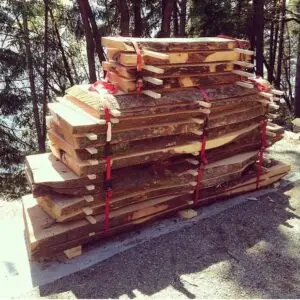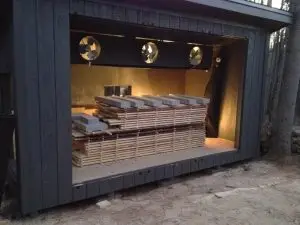Too much or too little moisture can severely affect your wooden floor. With too much moisture the wood will warp, and too little moisture will dry out the wood and cause it to fracture. Read on to learn more about the complex relationship between wood flooring and moisture.
How Moisture Affects Wood Flooring
Hardwood floorboards can contract or shrink when they lose moisture, creating gaps on the floor. This commonly occurs in cold weather, when the air is drier. These gaps in the floor will usually close up again when the temperatures warm up and the air becomes more humid. On the other hand, if the environment becomes too humid, wood will absorb the moisture in the air and expand. After only a few days of exposure to high humidity, floorboards may cup, crown, or even buckle. Once these problems happen, floorboards may never return to normal.
Kiln-Dried vs Air-Dried


Wood floorboards often are dried in a kiln, a type of large oven. Wood dried in Kilns is superior because kilns maintain a constant temperature, humidity, and airflow. This allows the wood to dry uniformly from all sides while preserving the required amount of water. In contrast, air-dried wood is subject to outside temperatures and humidity. This can cause problems such as raised grains, which you do not see in kiln-dried wood.
What is important to note is that wooden floorboards inside a kiln should be of equal size. If they are not – much like different-sized pieces of food cooked inside an oven – small pieces may burn while large pieces could be underdone.
The kiln should be heated before the boards are placed inside, with an inch of space between them. Small boards called stickers lay on top and at the ends of the boards to ensure the floorboards stay flat and receive adequate airflow. Once the stickers are on top of the first layer of boards, another layer can be placed on top of them. This stacking process can continue until the kiln is full. Once they’re thoroughly dry, wooden boards should be removed from the kiln and stored in a dry place.
Why You Need an Acclimation Process for Your Hardwood Floors
Before installing a hardwood floor the floorboards should be acclimated to the environment. The acclimation process is essential for helping the moisture content of wood flooring adjust to a new environment. It helps wood’s moisture content reach equilibrium with the environment. When this occurs, the wood does not gain or lose moisture.
Wooden floorboards should be stored in dry, controlled conditions that replicate the environment the flooring will experience. Storing them in the room the floorboards are meant for with air conditioning set at a constant, comfortable temperature is ideal. Garages and outdoor patio areas are not suitable because they can experience significant changes in temperature, humidity, and airflow. Cross-stacking wooden floorboards, with spacers between each layer, allows air to circulate around each board. Wherever possible, the flooring should be stored this way for at least three days before installation, as well as during and after installation.
A moisture meter can determine whether the wood’s moisture content is in equilibrium with the environment. If this is not achieved through the acclimation process, the wood might shrink, swell, warp, or suffer structural damage.
How to Create the Right Environment for Hardwood Flooring
Rooms with wood flooring should ideally be kept between 60 and 80 degrees F and at a relative humidity between 30 and 50 percent. This is roughly the same level that we find comfortable, so it’s fairly easy to keep your home at the right temperature and humidity levels for wood flooring. These conditions help wooden floorboards maintain the moisture content of 6 to 9 percent, which is recommended by manufacturers. Wood floors perform best when installed indoors.
How to Maintain the Balance
People living in either very arid or humid climates may find it difficult to create the ideal conditions for hardwood flooring. However, it is not an insurmountable problem. Dehumidifiers and humidifiers can modify a room’s humidity to make it more suited to wooden floors. Dehumidifiers remove humidity from the air, while humidifiers increase humidity levels. If you’re not sure how humid a room is, use a moisture meter. This gauge calculates a room’s humidity so you know whether it should be adjusted to create the ideal environment for your floor.
Engineered Hardwood Floors and Moisture
Engineered hardwood floors can be a good alternative to hardwood floors because they are more resistant to moisture damage. These floors have a stylish hardwood layer, commonly known as the wear layer, and a core made of plywood or fiberboard underneath. These two layers react differently to moisture.
An engineered floor’s core is typically more stable than solid hardwood because it’s made up of multiple layers of plywood or fiberwood. Its cross-ply construction significantly reduces shrinkage or expansion caused by spills or humid environments. Dramatic changes in humidity or excessive moisture will still affect an engineered floor’s core, but it can take a lot more moisture before changing shape. Engineered floorboards vary, though, so check the manufacturer’s instructions to determine the ideal humidity range for yours. As a rule, the better quality the engineered floorboards, the more moisture they can handle. Engineered wood is a good idea for bathrooms and kitchens.
How to Keep Your Hardwood Floors Looking Good
Keeping your wood flooring in the perfect humidity is an important step towards preserving them, but it’s not the only thing you should do to keep your wood floors looking their best. Remember these home maintenance tips to preserve your wood floors:
- Clean up any spilled water or other liquids immediately.
- Never use a damp mop on your wooden floor, as water will deteriorate the wood and damage its finish.
- Clean your wooden floor regularly with a cloth lightly dampened with a recommended wood cleaning product. Look for wooden floor care kits approved by your floor installer or retailers specializing in wooden floors. You can also safely sweep or vacuum your wooden floor.
Wood requires just the right amount of moisture to retain its integrity. Now that you understand how moisture affects hardwood flooring and how these elements working together will help you enjoy the wood in your life, you might be more comfortable choosing hardwood flooring for your home. Contact us if you would like to schedule a design consultation.
